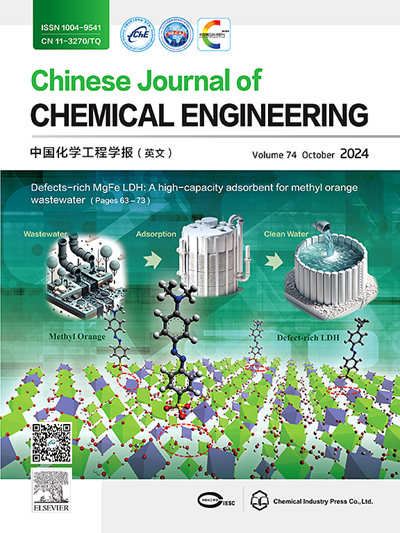微流控t型结中粘性液体的气泡破裂
IF 3.7
3区 工程技术
Q2 ENGINEERING, CHEMICAL
引用次数: 0
摘要
t型结微通道的气泡破裂是并行微通道中气液两相流计数的基础。本文研究了微流控t型结中粘性液体的气泡破裂。氮气作为气相,不同质量浓度的甘油-水混合物作为液相。探讨了微流控t型结气泡破裂时气液界面的演化过程。气泡颈的细化包括挤压阶段和快速掐断阶段。在挤压阶段,气泡颈最小宽度与时间呈幂律关系,α1和α2指数的取值受粘滞力的影响。前因子m1和m2的值与毛细管数呈负相关。在快速掐断阶段,气泡颈的减薄主要受表面张力的影响,气泡颈的最小宽度与剩余时间呈幂律关系。气泡尖端的传播可以用运动距离与时间之间的幂律来表征,指数随液体粘度的增加而减小。本文章由计算机程序翻译,如有差异,请以英文原文为准。
Bubble breakup in viscous liquids at a microfluidic T-junction
Bubble breakup at T-junction microchannels is the basis for the numbering-up of gas−liquid two-phase flow in parallelized microchannels. This article presents the bubble breakup in viscous liquids at a microfluidic T-junction. Nitrogen is used as the gas phase, and glycerol-water mixtures with different mass concentration of glycerol as the liquid phase. The evolution of the gas−liquid interface during bubble breakup at the microfluidic T-junction is explored. The thinning of the bubble neck includes the squeezing stage and the rapid pinch-off stage. In the squeezing stage, the power law relation is found between the minimum width of the bubble neck and the time, and the values of exponents α1 and α2 are influenced by the viscous force. The values of pre-factors m1 and m2 are negatively correlated with the capillary number. In the rapid pinch-off stage, the thinning of the bubble neck is predominated by the surface tension, and the minimum width of the bubble neck can be scaled with the remaining time as power-law. The propagation of the bubble tip can be characterized by the power law between the movement distance and the time, with decreasing exponent as increased liquid viscosity.
求助全文
通过发布文献求助,成功后即可免费获取论文全文。
去求助
来源期刊

Chinese Journal of Chemical Engineering
工程技术-工程:化工
CiteScore
6.60
自引率
5.30%
发文量
4309
审稿时长
31 days
期刊介绍:
The Chinese Journal of Chemical Engineering (Monthly, started in 1982) is the official journal of the Chemical Industry and Engineering Society of China and published by the Chemical Industry Press Co. Ltd. The aim of the journal is to develop the international exchange of scientific and technical information in the field of chemical engineering. It publishes original research papers that cover the major advancements and achievements in chemical engineering in China as well as some articles from overseas contributors.
The topics of journal include chemical engineering, chemical technology, biochemical engineering, energy and environmental engineering and other relevant fields. Papers are published on the basis of their relevance to theoretical research, practical application or potential uses in the industry as Research Papers, Communications, Reviews and Perspectives. Prominent domestic and overseas chemical experts and scholars have been invited to form an International Advisory Board and the Editorial Committee. It enjoys recognition among Chinese academia and industry as a reliable source of information of what is going on in chemical engineering research, both domestic and abroad.
 求助内容:
求助内容: 应助结果提醒方式:
应助结果提醒方式:


